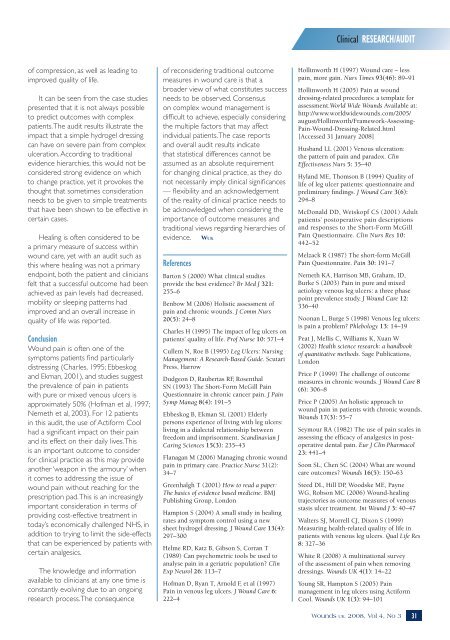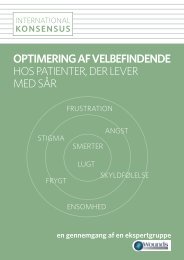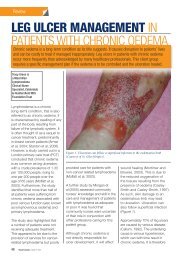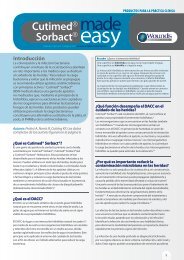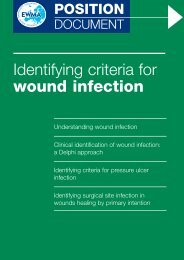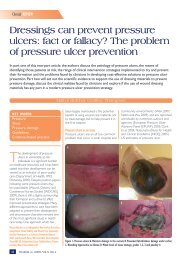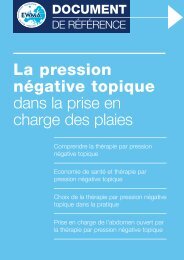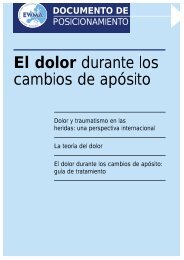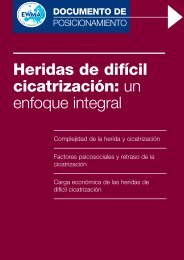VIEW PDF - Wounds UK
VIEW PDF - Wounds UK
VIEW PDF - Wounds UK
You also want an ePaper? Increase the reach of your titles
YUMPU automatically turns print PDFs into web optimized ePapers that Google loves.
Clinical RESEARCH/AUDITof compression, as well as leading toimproved quality of life.It can be seen from the case studiespresented that it is not always possibleto predict outcomes with complexpatients. The audit results illustrate theimpact that a simple hydrogel dressingcan have on severe pain from complexulceration. According to traditionalevidence hierarchies, this would not beconsidered strong evidence on whichto change practice, yet it provokes thethought that sometimes considerationneeds to be given to simple treatmentsthat have been shown to be effective incertain cases.Healing is often considered to bea primary measure of success withinwound care, yet with an audit such asthis where healing was not a primaryendpoint, both the patient and cliniciansfelt that a successful outcome had beenachieved as pain levels had decreased,mobility or sleeping patterns hadimproved and an overall increase inquality of life was reported.ConclusionWound pain is often one of thesymptoms patients find particularlydistressing (Charles, 1995; Ebbeskogand Ekman, 2001), and studies suggestthe prevalence of pain in patientswith pure or mixed venous ulcers isapproximately 50% (Hofman et al, 1997;Nemeth et al, 2003). For 12 patientsin this audit, the use of Actiform Coolhad a significant impact on their painand its effect on their daily lives. Thisis an important outcome to considerfor clinical practice as this may provideanother ‘weapon in the armoury’ whenit comes to addressing the issue ofwound pain without reaching for theprescription pad. This is an increasinglyimportant consideration in terms ofproviding cost-effective treatment intoday’s economically challenged NHS, inaddition to trying to limit the side-effectsthat can be experienced by patients withcertain analgesics.The knowledge and informationavailable to clinicians at any one time isconstantly evolving due to an ongoingresearch process. The consequenceof reconsidering traditional outcomemeasures in wound care is that abroader view of what constitutes successneeds to be observed. Consensuson complex wound management isdifficult to achieve, especially consideringthe multiple factors that may affectindividual patients. The case reportsand overall audit results indicatethat statistical differences cannot beassumed as an absolute requirementfor changing clinical practice, as they donot necessarily imply clinical significances— flexibility and an acknowledgementof the reality of clinical practice needs tobe acknowledged when considering theimportance of outcome measures andtraditional views regarding hierarchies ofevidence. W<strong>UK</strong>ReferencesBarton S (2000) What clinical studiesprovide the best evidence? Br Med J 321:255–6Benbow M (2006) Holistic assessment ofpain and chronic wounds. J Comm Nurs20(5): 24–8Charles H (1995) The impact of leg ulcers onpatients’ quality of life. Prof Nurse 10: 571–4Cullem N, Roe B (1995) Leg Ulcers: NursingManagement: A Research-Based Guide. ScutariPress, HarrowDudgeon D, Raubertas RF, RosenthalSN (1993) The Short-Form McGill PainQuestionnaire in chronic cancer pain. J PainSymp Manag 8(4): 191–5Ebbeskog B, Ekman SL (2001) Elderlypersons experience of living with leg ulcers:living in a dialectal relationship betweenfreedom and imprisonment. Scandinavian JCaring Sciences 15(3): 235–43Flanagan M (2006) Managing chronic woundpain in primary care. Practice Nurse 31(2):34–7Greenhalgh T (2001) How to read a paper:The basics of evidence based medicine. BMJPublishing Group, LondonHampton S (2004) A small study in healingrates and symptom control using a newsheet hydrogel dressing. J Wound Care 13(4):297–300Helme RD, Katz B, Gibson S, Corran T(1989) Can psychometric tools be used toanalyse pain in a geriatric population? ClinExp Neurol 26: 113–7Hofman D, Ryan T, Arnold F, et al (1997)Pain in venous leg ulcers. J Wound Care 6:222–4Hollinworth H (1997) Wound care – lesspain, more gain. Nurs Times 93(46): 89–91Hollinworth H (2005) Pain at wounddressing-related procedures: a template forassessment.World Wide <strong>Wounds</strong> Available at:http://www.worldwidewounds.com/2005/august/Hollinworth/Framework-Assessing-Pain-Wound-Dressing-Related.html[Accessed 31 January 2008]Husband LL (2001) Venous ulceration:the pattern of pain and paradox. ClinEffectiveness Nurs 5: 35–40Hyland ME, Thomson B (1994) Quality oflife of leg ulcer patients: questionnaire andpreliminary findings. J Wound Care 3(6):294–8McDonald DD, Weiskopf CS (2001) Adultpatients’ postoperative pain descriptionsand responses to the Short-Form McGillPain Questionnaire. Clin Nurs Res 10:442–52Melzack R (1987) The short-form McGillPain Questionnaire. Pain 30: 191–7Nemeth KA, Harrison MB, Graham, ID,Burke S (2003) Pain in pure and mixedaetiology venous leg ulcers: a three phasepoint prevalence study. J Wound Care 12:336–40Noonan L, Burge S (1998) Venous leg ulcers:is pain a problem? Phlebology 13: 14–19Peat J, Mellis C, Williams K, Xuan W(2002) Health science research: a handbookof quantitative methods. Sage Publications,LondonPrice P (1999) The challenge of outcomemeasures in chronic wounds. J Wound Care 8(6): 306–8Price P (2005) An holistic approach towound pain in patients with chronic wounds.<strong>Wounds</strong> 17(3): 55–7Seymour RA (1982) The use of pain scales inassessing the efficacy of analgesics in postoperativedental pain. Eur J Clin Pharmacol23: 441–4Soon SL, Chen SC (2004) What are woundcare outcomes? <strong>Wounds</strong> 16(5): 150–63Steed DL, Hill DP, Woodske ME, PayneWG, Robson MC (2006) Wound-healingtrajectories as outcome measures of venousstasis ulcer treatment. Int Wound J 3: 40–47Walters SJ, Morrell CJ, Dixon S (1999)Measuring health-related quality of life inpatients with venous leg ulcers. Qual Life Res8: 327–36White R (2008) A multinational surveyof the assessment of pain when removingdressings. <strong>Wounds</strong> <strong>UK</strong> 4(1): 14–22Young SR, Hampton S (2005) Painmanagement in leg ulcers using ActiformCool. <strong>Wounds</strong> <strong>UK</strong> 1(3): 94–101<strong>Wounds</strong> <strong>UK</strong>, 2008, Vol 4, No 331


